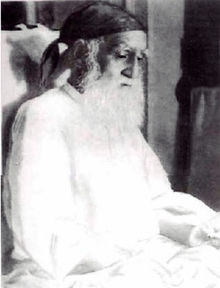Related Research Articles

Kamaluddin Yahya Maneri popularly known as Makhdoom Yahya Maneri was an Indian Sufi saint of the 13th century. His tomb is known as Badi Dargah, near a mosque located in Maner Sharif, 29 km from Patna, Bihar, India.

Pir Meher Ali Shah, was a Punjabi Muslim Sufi scholar and mystic poet from Punjab, British India. Belonging to the Chishti order, he is known as a Hanafi scholar who led the anti-Ahmadiyya movement. He wrote several books, most notably Saif e Chishtiyai, a polemical work criticizing the Ahmadiyya movement of Mirza Ghulam Ahmad.
Syed Shah Ata Hussain Fani Chishti (1816–1893), popularly known as Khwaja-e-Bihar was an Indian Sufi saint of the Chisti Order. He was the first Sufi to go into the completely non-Muslim locality of Gaya and spread Islam. He was also a writer, poet, linguist, and orator. He died as the Ghaus, which is the highest degree of spirituality a Sufi could attain in his time.

Shah Niyaz Ahmad (1742-1834) was a Sufi, poet and author from India.
Muhammad Sirajuddin Naqshbandi was a prominent Islamic scholar and Sufi shaikh of the Naqshbandi Sufi order in South Asia. He was born in 1879 and died in 1915 at Mussa Zai Sharif, Dera Ismail Khan. His legacy and influence are still widespread around the world in terms of his followers and his methodology.
A Qayyum is a special spiritual position in Sufism, especially in the Naqshbandi tradition. The term was first coined by Ahmed Sirhindi, who was the first qayyum. According to him, a qayyum is a dignitary upon whom the whole order of existence depends. The word is derived from Al-Qayyum, a name of God in Islam that has the same meaning. According to the doctrine, only one qayyum is alive at any particular time.
Qazi Syed Inayatullah was a scholar of Fiqh from Sakras, District Mewat (Haryana). He belonged to the family of Gardēzī Sadaat.
Syed Shah Mehr Ali Alquadri Al Baghdadi, commonly known as "Syedena Aala Huzur", was a famous saint of Bengal. He established Khanqah for promotion and propagation of Quadria Order. His shrine is a centre of pilgrims in Midnapore.

Shah Inayatullah, popularly known as Sufi Shah Inayat Shaheed, Shah Shaheed or Shah Inayat of Jhok, was a 17th-century Sindhi Sufi saint and revolutionary from Jhok. He was the first socialist and agricultural reformist of Sindh.

Sayyid Muḥammad ʿAmīmul Eḥsān al-Barkatī was a Bangladeshi Islamic scholar who served as the third Khatib of the Baitul Mukarram National Mosque.
Sufism in Sindh covers the tradition of Sufism in Sindh, which is reputed to be an area of mystics. Sindh is famous for the enormous number of saints and mystics who lived there and preached peace and brotherhood. According to popular legend, 125,000 of them are buried on Makli Hill near Thatta. There is an abundance of Sufi literature produced in Sindh throughout history.

Sharfuddin Ahmed Yahya Maneri, popularly known as Makhdoom-ul-Mulk Bihari and Makhdoom-e-Jahan (1263–1381), was a 13th-century Sufi mystic.

Yunus Ali Enayetpuri, or simply Khwaja Enayetpuri, was a Sufi saint. He was one of the most influential Sufis in Bangladesh in 20th century. His followers numbered in the hundreds of thousands. A number of khanqahs are operated by his successors, including Bangladesh's largest Khanqahs and also the light still shinning from his chain in a Darbar Sharif called Ajadia Pak Darbar Sharif(আজাদীয়া পাক দরবার শরীফ) Sharif located in Sirajganj city.
Makhdoom Shah Maroof Khushabi was a sufi, saint and preacher of Islamic of Qadiriyya Silsila. He was the successor of Shah Mubarak Haqani. He was a member of the Chishti Order and the Qadiriyya order.
Shāh Amānat Khān, was an 18th-century Sufi Muslim figure in South Asia. He is regarded as one of the most prominent saints of Chittagong, in eastern Bengal.

Pir Hadi Hassan Bux Shah Jilani, commonly known by the title Hadi, was a Sufi saint and poet from Sanghar in modern-day Pakistan who belonged to Qadiriyya Sufi order. He was born at Dargah Bhuro Bhawan Shah Jilani near Hyderabad, Sindh and lived most of his life in Duthro Sharif Sanghar Sindh after traveling through Sindh to spread Islam and Sufism. He wrote his poetry in many languages, mostly in Sindhi but also in Urdu, Persian and other languages. The annual Urs of Hadi take place in the month of Jumada al-Awwal in Duthro Sharif Sanghar.

Shah Akbar Danapuri (1844–1914) also known as Shah Muhammad Akbar Abulolai Danapuri was an Indian Islamic scholar, writer and Sufi poet. He belonged to the Naqshbandi Abulolaiya order of Sufism. He was contemporary of Imam Ahmed Raza Khan Barelvi and Waris Ali Shah. He had served as the Sajjadanasheen of Khanqah Sajjadiya-Abulolaiya from 1884 to 1914. He was a student of Waheed Allahabadi, a disciple of Khwaja Haidar Ali Atish. He was the teacher of Zohra Bai.
References
- ↑ Qadri Munawwari 2015, p. 13.
- ↑ "Hazrat Makhdoom Shah Muhammad Munim Pak r.a". Aal-e-Qutub Aal-e-Syed Abdullah Shah Ghazi. 2018-11-12. Retrieved 2023-06-18.
- ↑ Hyat-Khan, Sardar Taimur (2021-01-01). "Shajra Sharif Firdausiya Sillsila Awwal Nisbat". Shajra Sharif Firdausiya Sillsila Awwal Nisbat.
- ↑ Qadri Munawwari & 15, p. 13.
- ↑ FANI DANAPURI, SHAH ATA HUSAIN. KAIFYATUL ARFEEN.
- ↑ Qadri Munawwari 2015, p. 14.
- ↑ Qadri Munawwari 2015, p. 15-16, 19-20.
Bibliography
- Hayatullah, Shah. Hujjatul Aarifeen. Mitan Ghat, Patna: Khanqah Munemia Qamaria.
- Qadri Munawwari, Syed Faiz Ahmad (2015). An Introduction to Khanqah Munemia. Mitan Ghat, Patna: Khanqah Munemia Qamaria. ISBN 9788192096209.